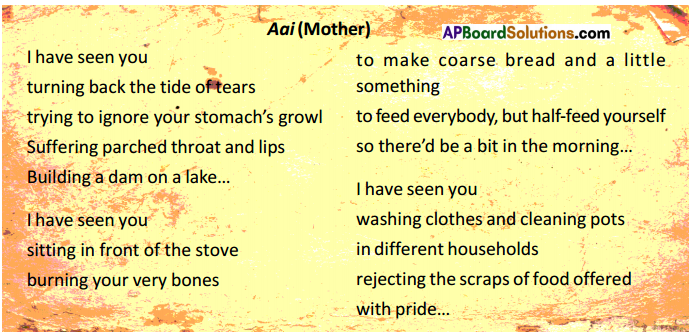AP State Syllabus AP Board 7th Class Science Important Questions Chapter 10 Nutrition in Plants
AP State Syllabus 7th Class Science Important Questions 10th Lesson Nutrition in Plants
7th Class Science 10th Lesson Nutrition in Plants Important Questions and Answers
Question 1.
How is the process of photosynthesis carried on in plants?
Answer:
- We know that plants take water through their roots and air though the stomata of their leaves. (There are some other parts like loose tissues and lenticels present on the bark of plant through which exchange of air takes place).
- We also know that leaves contain the green substance, chlorophyll.
- In the presence of sun light the process of photosynthesis takes place as follows. Green parts of plants use carbon dioxide in the presence of sunlight along with water to make glucose starch and other food materials.

![]()
Question 2.
What effect light has on the formation of starch in leaves? Describe an activity to find out.
Answer:
- We need to find out if starch is present in leaves. We already know how to test for starch, but a problem arises if we try this test with leaves.
- Leaves are green in colour. When iodine solution is put on a leaf, it should turn blue if starch is present.
- However, the green colour of the leaf disguises the blue colour.
- So we must first remove the green colour of the leaves if we want to test whether they contain starch.
- The way to do this is to first put the leaves in a boiling tube and boil them in alcohol.
- 4 to 5 leaves of a plant were plucked in the afternoon.
- After removing their green colour in the way described above, they were put in diluted iodine solution.
- The leaves turned black.

- It means the leaves has starch in them.
- In the second part of the experiment, 4 to 5 leaves of the same plant were covered with black paper without removing them from the plant.
- The way the black paper was cut and fixed to the leaves is shown in the figure.
- These leaves were plucked two days later. Their green colour was removed and they were dipped in iodine solution.
- The leaves turned black in the pattern shown in the figure.
- We will notice with the iodine solution test that starch was not present in the portion of the leaves covered with black paper.
- This experiment confirms that light is essential for the formation of startch in plants.
Question 3.
Do plants produce only starch? If not, what are the other compounds it could produce? explain.
Answer:
- We know that starch, fats and proteins are present in food.
- They are also present in plants.
- Plants produce sugar first, which is converted to starch and then another compound as well.
- But plants need other nutrient elements to do this.
![]()
Question 4.
What are the main nutrients for plants ? What do you mean by micronutrients?
Answer:
- The main nutrients needed are nitrogen, potassium and phosphorus.
- Plants require many other nutrient elements as well, but these are needed only in minute quantities.
- Hence, they are called micronutrients.
- Plants absorb these nutrient elements from the soil through their roots.
Question 5.
What is Cuscuta? Explain what is meant by hetero trophic nutrition.
Answer:
- We see yellow thread-like structures twining around the stem, branches and leaves of some trees.
- Figure shows such a plant.
- This thread-like plant is Cuscuta. It neither has leaves nor Chlorophyll.
- Cuscuta takes food from the plant on which it is climbing.

- Like humans and animals such plants depend on the food produced by other plants.
- This mode of nutrition is called heterotrophic nutrition.
Question 6.
What are saprophytes? Where do they grow?
Answer:
- Often after rains we find umbrella like structures growing from the ground.
- Such plants are called saprophytes.
- They grow on dead / decaying matter.
- Mushrooms belong to this type of plants.
![]()
Question 7.
What is fungi? Where do you find it?
Answer:
- Black and white spots appearing on bread pieces, pickles, when kept in moist places. These spots develop due to the growth of fungi, which is a type of plant.
- All these types of plants do not contain chlorophyll so they simply absorb organic material usually from decaying matter.
Question 8.
Write a brief note on ‘insectivorous plants’.
Answer:
- A few plants manufacture their own food but also obtain a part of their nutrition from insects.
- Leaves of these plants are specially modified to trap insects.
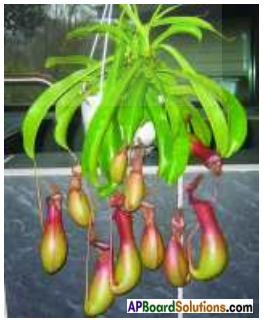
- These plants grow in areas deficient in nitrogen.
- Hence they meet their nitrogen requirements from insects.
- Being green in colour, they can manufacture their own food.
- Droseras, Utricularia, Venusflytrap are examples of some such insectivorous plants.
- These are also called as carnivorous plants.
Question 9.
Mention some plants on whose roots bacteria grow.
Answer:
Some plants like those of the Dal family have a type of bacteria growing on their roots in nodules. The bacteria fixes nitrogen for the plant while it gets shelter in the roots of these plants. Such an association is beneficial to both groups and called symbiosis.

![]()
Question 10.
What are Lichens? Write a note about it.
Answer:
There are colonies of algae and fungi living together in a symbiotic relationship. These colonies are known as Lichens. This relationship starts with the attack of the algal colony by a type of fungus. It is an example of balanced parasitism then. Later as algae survive, they are given protection from intense light and conditions of drying up due to the presence of fungus colony. The fungus gets food from its partner.
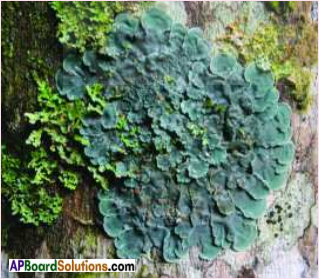
Question 11.
Describe the experiment conducted by Jan Baptista Von Helmont and discuss his results.
Answer:
- In the year 1648 a Belgian scientist Jan Baptista Von Helmont conducted an experiment that continued for five years.

- He took a small willow tree and planted it in a large pot of soil.
- Before he did this he carefully measured the mass of the dry soil and the mass of the tree.
- He covered the soil with a lid so that nothing could fall onto the surface of the soil and add to its mass.
- There were holes in the lid so that the tree could grow out of the soil and so that air and water could reach the roots. Von Helmont left the tree for five years, giving it only rain water to drink.

- At the end of the five years he measured the mass of the tree and the mass of the dry soil for a second time.
- The results of this experiment are shown below.
- This experiment changed the belief of hundreds of years. This was because Von Helmont arrived at a result that –

a) The substances needed for the growth of a plant do not come from the soil only.
b) The plant grow because of the water it gets.
![]()
Question 12.
Who was the first to point out a possible role of light in plant nutrition?
Answer:
- People tried to check the conclusions of Von Helmont and thus experiment after experiment followed.

- Stephan Hales described the leaves as organs of transpiration (loss of excess water from plant body) and he said that plants exchange gases with their surrounding air.
- Furthermore, he was the first to point out a possible role of light in plant nutrition.
Question 13.
List the four major things needed by plants to carry out the process of photosynthesis.
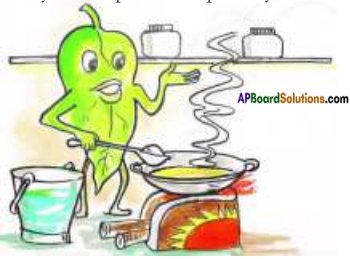
Answer:
- In nature, the presence of the green substance in leaves is essential for photosynthesis to take place.
- This green substance is called chlorophyll. Plants get water from the soil through their roots while the process of photosynthesis takes place in the leaves.

Question 14.
Why is it necessary to irrigate the fields after sprinkling urea?
Answer:
- Farmers sprinkle urea in rice or wheat fields whenever the leaves turn yellow.
- The leaves soon become green again.
- After sprinkling urea, farmers irrigate their fields.
- Urea dissolves in water and stay near the roots of the rice plants.
- The plants absorb this urea dissolved in water through their roots.
- This is the reason why farmers irrigate the fields after sprinkling urea.
- The rice or wheat plants get water and other nutrients dissolved in it thus.
![]()
Question 15.
How does the exchange of air take place in plants?
Answer:
- Plants get water from the soil through their roots.
They use carbon dioxide of air. This job is done by the leaves. - The leaves have tiny holes through which the exchange of air takes place.

- These holes are so minute we can only see them with the help of a microscope.
- They are called stomata.
- It is through the stomata that the exchange of air in leaves takes place continuously.
Question 16.
Draw a diagram of mango tree and write its soliloquy.
Answer:

Question 17.
How do parasitic plants get food from the host plants?
Answer:
Parasitic plants develop special roots called haustoria, which penetrate into the tissues * of the host plant and absorb food materials from them.
Question 18.
What is herberium? How is it useful to us?
Answer:
- Preservation of plant parts like leaves, flowers or whole plant is a traditional designery art.
- If the plants are not available in a particular place then the plant physiologists collect those plants where they available and make them in the preservative form.
- This is commonly known as herberium.
- They study those plants, and these preserved plants also helpful for the future studies.
![]()
Question 19.
Read the para and answer the quesions given below.
Cascuta is a parasitic plant. This receives nutrients from the host plant. It has a finger like structure called haustoria. It inserts it into the stem of the host and receives nutrients.
- Why do we call Cascuta a parasitic plant?
- What helps to receive nutrients in Cascuta?
- Why does Cascuta depend on host for nutrition?
- Give some more examples of parasitic plants.
Answer:
- Because Cascuta depends on other plants for food.
- Haustoria.
- As Cascuta has no chloroplasts to perform photosynthesis, it depends on other plants for food.
- a) Corpse flower (Rafflesia plant)
b) Hydnora plant
c) Thurber’s stem sucker.
Question 20.
What happens if the stomata is absent in the plants?
Answer:
- If there are no stomata in plant, transpiration will not occur.
- Moreover, the gaseous exchange (CO2, O2) will not take place in plants.
- Photosynthesis will not occur in plants.
Question 21.
In human beings respiratory organs are lungs. What are the respiratory organs of plants?
Answer:
Stomata act as respiratory organs in plants.


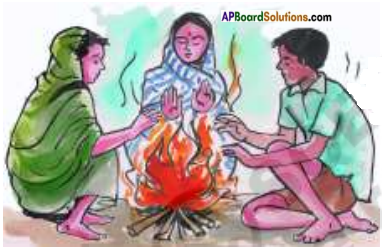



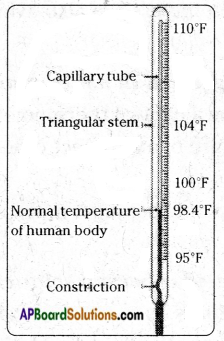






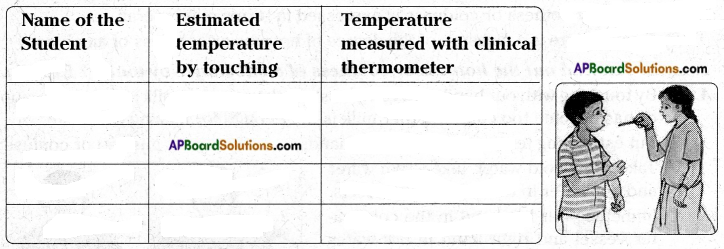






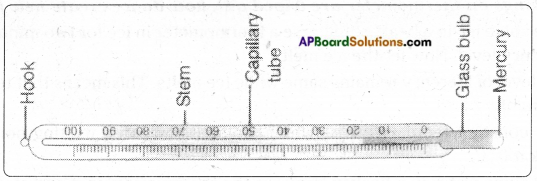
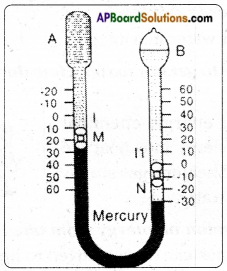

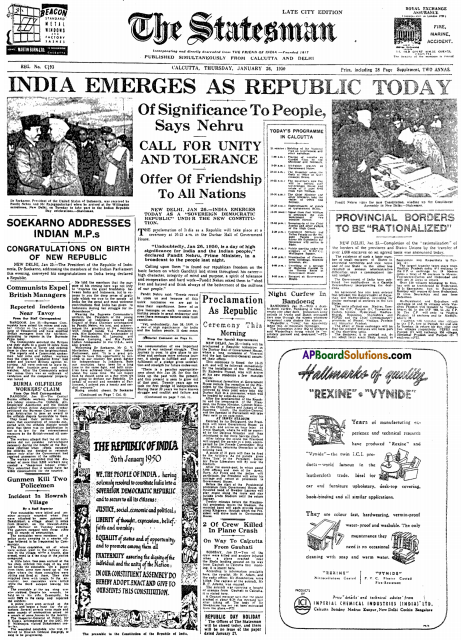 Answer:
Answer:

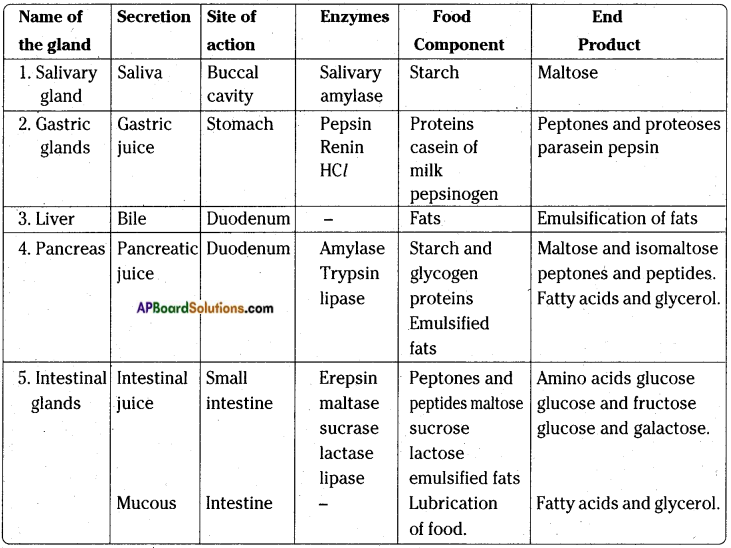
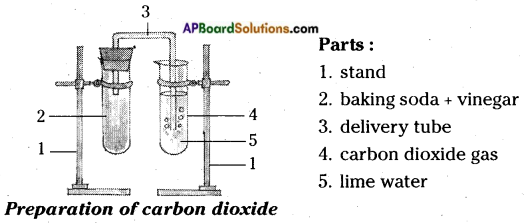
 Many people have argued for localisation of food production rather than food travelling long distances. How is localisation of food connected to the environment ? Find out more about the localisation movement in food and organise a discussion and debate in the classroom.
Many people have argued for localisation of food production rather than food travelling long distances. How is localisation of food connected to the environment ? Find out more about the localisation movement in food and organise a discussion and debate in the classroom.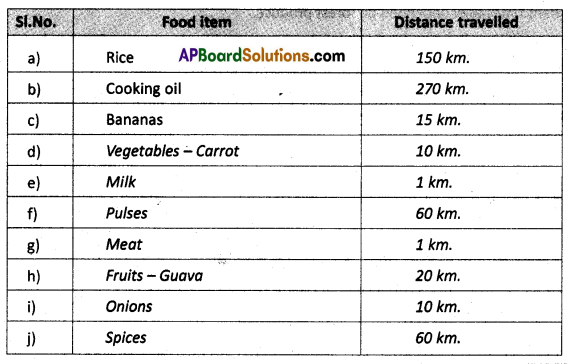
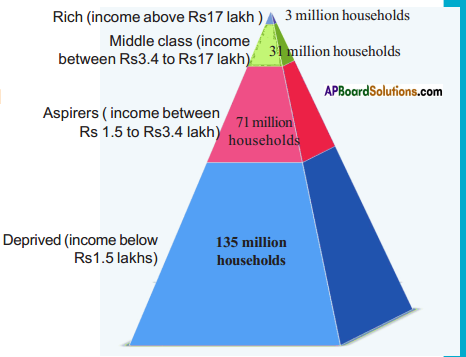

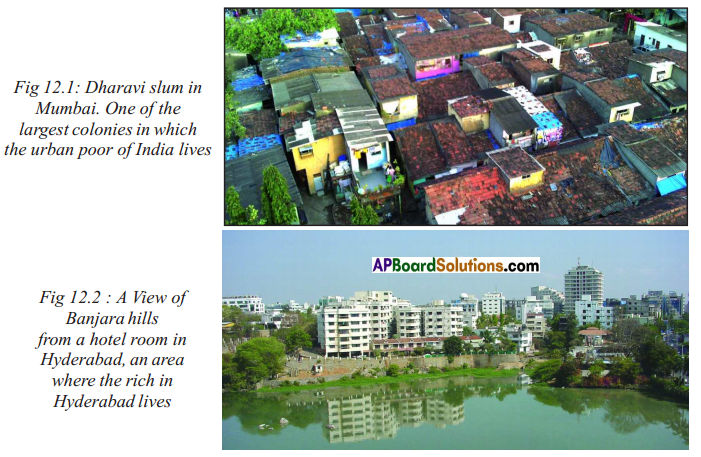 Answer:
Answer: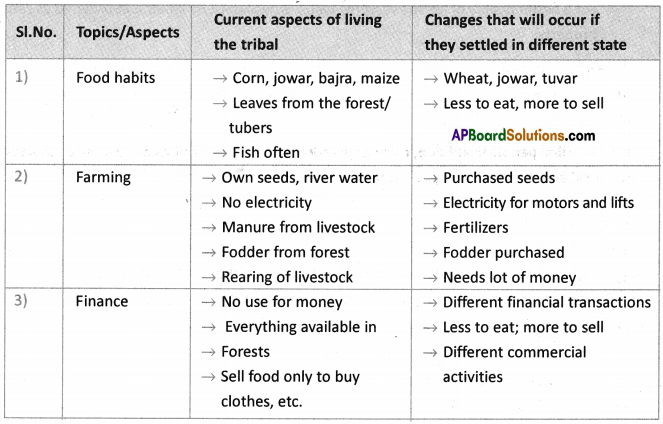
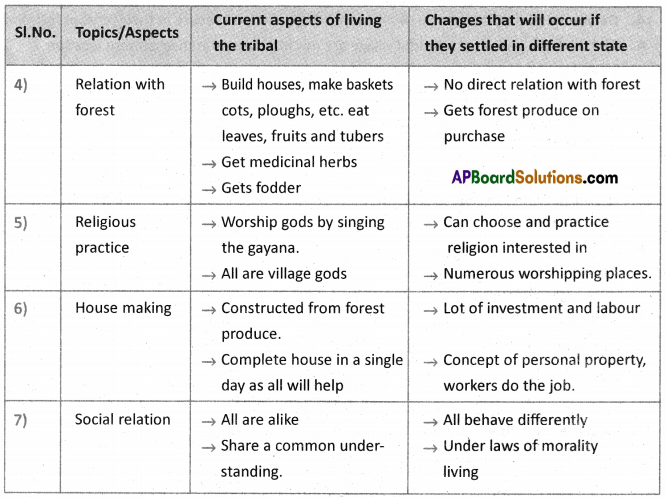
 Write your caption in the context of the environment.
Write your caption in the context of the environment.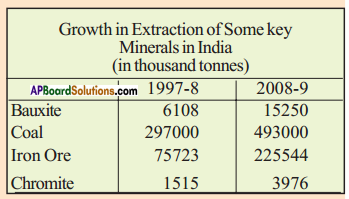 Answer:
Answer: Write your caption in the context of development.
Write your caption in the context of development. Answer:
Answer: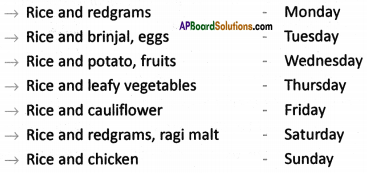
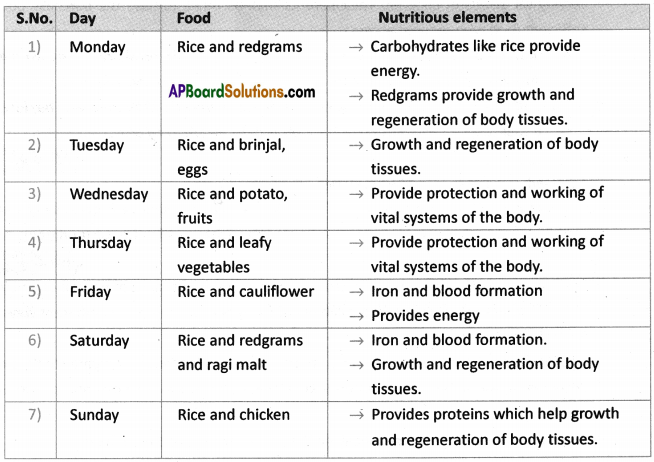
 Answer:
Answer: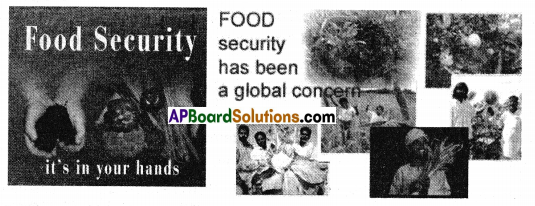
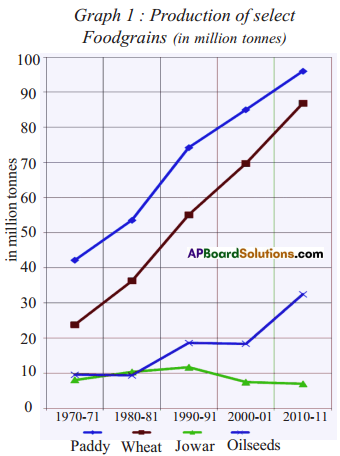 The food grains production has grown over the period 1970-71 to ——–. Paddy production increased from about 40 million tonnes in 1970-71 to about ——– million tonnes in 2010-11. Another important food crop that witnessed rapid increase in production during this 40 years period was ——–. Compared to paddy and wheat the production of ——– did not increase during 1970-2011. This could be due to ——–.
The food grains production has grown over the period 1970-71 to ——–. Paddy production increased from about 40 million tonnes in 1970-71 to about ——– million tonnes in 2010-11. Another important food crop that witnessed rapid increase in production during this 40 years period was ——–. Compared to paddy and wheat the production of ——– did not increase during 1970-2011. This could be due to ——–.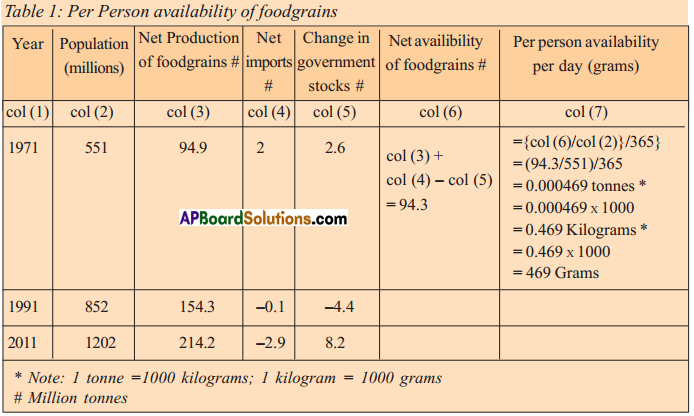 Answer:
Answer:
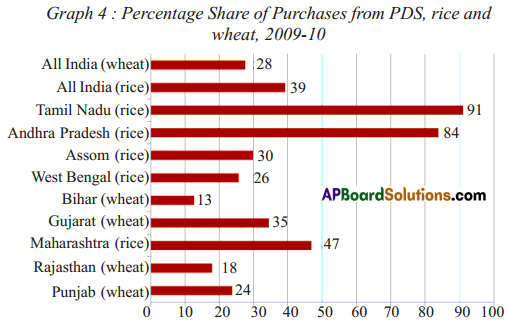
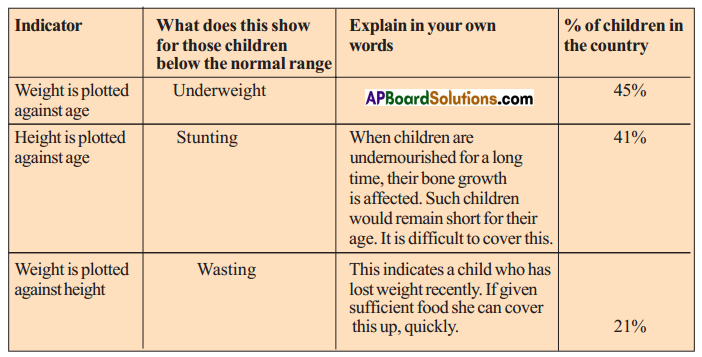
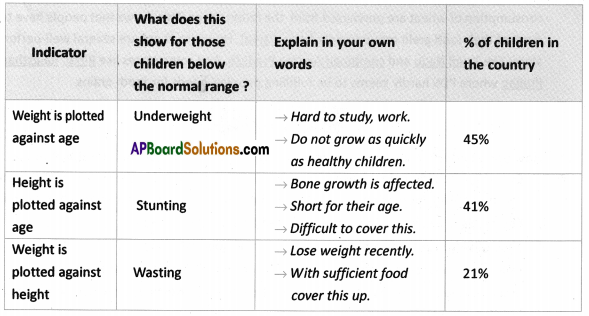 When weight is plotted against age nearly 45% of children in the country are under weight. It means that they cannot study, work or perform physical activities. They do not grow as quickly as healthy children. Their immune system is weakened. When height is plotted against age 41% of children not up to the height they have to be. It seems their growth is affected and short for their age. They are difficult to cover this. When weight is plotted against height 21% children are not with weight they are supposed to be. With sufficient food they can cover this up.
When weight is plotted against age nearly 45% of children in the country are under weight. It means that they cannot study, work or perform physical activities. They do not grow as quickly as healthy children. Their immune system is weakened. When height is plotted against age 41% of children not up to the height they have to be. It seems their growth is affected and short for their age. They are difficult to cover this. When weight is plotted against height 21% children are not with weight they are supposed to be. With sufficient food they can cover this up.